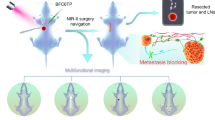Abstract
Two-photon excited fluorescence (TPEF) microscopy, based on signal from cells, can provide detailed information on tissue architecture and cellular morphology in unstained histological sections to generate subcellular-resolution images from tissue directly. In this paper, we used TPEF microscopy to image microstructure of human normal gallbladder and three types of differentiated carcinomas in order to investigate the morphological changes of tissue structure, cell, cytoplasm, and nucleus without hematoxylin and eosin (H&E) staining. It displayed that TPEF microscopy can well image the stratified normal gallbladder tissue, including the mucosa, the muscularis, and the serosa. The typical cancer cell, characterized by cellular and nuclear pleomorphism, enlarged nuclei, and augmented nucleolus, can be identified in histological sections without H-E staining as well. The quantitative results showed that the areas of the nucleus and the nucleolus in three types of cancerous cells were all significantly greater than those in normal gallbladder columnar epithelial cells derived from TPEF microscopic images. The studies demonstrated that TPEF microscopy has the ability to characterize tissue structures and cell morphology of gallbladder cancers differentiated from a normal gallbladder in a manner similar to traditional histological analysis. As a novel tool, it has the potential for future retrospective studies of tumor staging and migration by utilizing histological section specimens without H-E staining.





Similar content being viewed by others
References
Misra S, Chaturvedi A, Misra NC, Sharma ID (2003) Carcinoma of the gallbladder. Lancet Oncol 4:167–176. doi:10.1016/S1470-2045(03)01021-0
Lai CH, Lau WY (2008) Gallbladder cancer—a comprehensive review. Surgeon 6:101–110. doi:10.1016/S1479-666X(08)80073-X
Laitio M (1983) Histogenesis of epithelial neoplasms of human gallbladder II: classification of carcinoma on the basis of morphological features. Pathol Res Pract 178:57–66. doi:10.1016/S0344-0338(83)80086-7
Susumu N, Masami Y, Eiichi T (1989) Morphometric analysis of gallbladder adenocarcinoma: discrimination between carcinoma and dysplasia. Virchows Archiv A Pathol Anat 416:133–140. doi:10.1007/BF01606318
Henson DE, Albores-Saavedra J, Corle D (1992) Carcinoma of the gallbladder: histologic types, stage of disease, grade, and survival rates. Cancer 70:1493–1497. doi:10.1002/1097-0142
Levy AD, Murakata LA, Rohrmann CA Jr (2001) Gallbladder carcinoma: radiologic-pathologic correlation. Radiographics 21:295–314. doi:10.1148/radiographics.21.2.g01mr16295
Hundal R, Shaffer EA (2014) Gallbladder cancer: epidemiology and outcome. J Clin Epidemiol 6:99–109. doi:10.2147/CLEP.S37357
Zevallos Maldonado C, Ruiz Lopez MJ, Gonzalez Valverde FM, Alarcon Soldevilla F, Pastor Quirante F, Garcia Medina V (2014) Ultrasound findings associated to gallbladder carcinoma. Cir Espen 92:348–355. doi:10.1016/j.ciresp.2012.10.007
Ramos-Font C, Gomez-Rio M, Rodriguez-Fernandez A, Jimenez-Heffernan A, Sanchez Sanchez R, Llamas-Elvira JM (2014) Ability of FDG-PET/CT in the detection of gallbladder cancer. J Surg Oncol 109:218–224. doi:10.1002/jso.23476
Lee NK, Kim S, Kim TU, Kim DU, Seo HI, Jeon TY (2014) Diffusion-weighted MRI for differentiation of benign from malignant lesions in the gallbladder. Clin Radiol 69:e78–e85. doi:10.1016/j.crad.2013.09.017
Larson K, Ho HH, Anumolu PL, Chen TM (2011) Hematoxylin and eosin tissue stain in Mohs micrographic surgery: a review. Dermatol Surg 37:1089–1099. doi:10.1111/j.1524-4725.2011.02051.x
Gill GW (2010) H&E Staining. In: Kumar GL, Kiernan JA (eds) Education guide: special stains and H&E, 2nd edn. Dako North America, California, pp 177–184
Denk W, Strickler J, Webb WW (1990) Two-photon laser scanning fluorescence microscopy. Science 248:73–76. doi:10.1126/science.2321027
Zipfel WR, Williams RM, Webb WW (2003) Nonlinear magic: multiphoton microscopy in the biosciences. Nat Biotechnol 21:1369–1377. doi:10.1038/nbt899
Zipfel WR, Williams RM, Christie R, Nikitin AY, Hyman BT, Webb WW (2003) Live tissue intrinsic emission microscopy using multiphoton-excited native fluorescence and second harmonic generation. Proc Natl Acad Sci USA 100:7075–7080. doi:10.1073/pnas.0832308100
Yan J, Chen G, Chen J, Liu N, Zhuo S, Yu H, Ying M (2011) A pilot study of using multiphoton microscopy to diagnose gastric cancer. Surg Endosc 25:1425–1430. doi:10.1007/s00464-010-1409-z
Pavlova I, Hume KR, Yazinski SA, Peters RM, Weiss RS, Webb WW (2010) Multiphoton microscopy as a diagnostic imaging modality for lung cancer. Proc Soc Photo Opt Instrum Eng 7569:756918. doi:10.1117/12.841017
Wu X, Chen G, Lu J, Zhu W, Qiu J, Chen J, Xie S, Zhuo S, Yan J (2013) Label-free detection of breast masses using multiphoton microscopy. PLoS ONE 8:e65933. doi:10.1371/journal.pone.0065933
Madden KS, Zettel ML, Majewska AK, Brown EB (2013) Brain tumor imaging: live imaging of glioma by two-photon microscopy. Cold Spring Harb Protoc. doi:10.1101/pdb.prot073668, 3: pdb-prot073668
Yan J, Zhuo S, Chen G, Wu X, Zhou D, Xie S, Jiang J, Ying M, Jia F, Chen J, Zhou J (2012) Preclinical study of using multiphoton microscopy to diagnose liver cancer and differentiate benign and malignant liver lesions. J Biomed Opt 17:0260041–0260047. doi:10.1117/1.JBO.17.2.026004
Tuer A, Tokarz D, Prent N, Cisek R, Alami J, Dumont DJ, Bakueva L, Rowlands J, Barzda V (2010) Nonlinear multicontrast microscopy of hematoxylin-and-eosin-stained histological sections. J Biomed Opt 15:026018. doi:10.1117/1.3382908
Chen J, Xu J, Kang D, Xu M, Zhuo S, Zhu X, Jiang X (2013) Multiphoton microscopic imaging of histological sections without hematoxylin and eosin staining differentiates carcinoma in situ lesion from normal oesophagus. Appl Phys Lett 103:183701. doi:10.1063/1.4826322
Xu J, Kang D, Xu M, Zhuo S, Zhu X, Chen J (2013) Multiphoton microscopic imaging of esophagus during the early phase of tumor progression. Scanning 35:387–391. doi:10.1002/sca.21079
Manuelidis L (1984) Active nucleolus organizers are precisely positioned in adult central nervous system cells but not in neuroectodermal tumor cells. J Neuropathol Exp Neurol 43:225–241
Rüschoff J (1992) Nucleolus organizer regions in pathomorphologic tumor diagnosis. Veroff Pathol 139:1–144
Acknowledgments
The project was supported by the Program for Changjiang Scholars and Innovative Research Team in University (Grant No. IRT1115), the National Natural Science Foundation of China (Grant Nos. 81101209, 61275006, and 81271620), the Natural Science Foundation for Distinguished Young Scholars of Fujian Province (2014 J06016), and the China Scholarship Council Funding.
Conflict of interest
The authors declare that they have no conflict of interest.
Author information
Authors and Affiliations
Corresponding authors
Additional information
Zhipeng Hong, Youting Chen, and Jing Chen contributed equally to this work.
Rights and permissions
About this article
Cite this article
Hong, Z., Chen, Y., Chen, J. et al. Optical diagnosis of gallbladder cancers via two-photon excited fluorescence imaging of unstained histological sections. Lasers Med Sci 30, 225–233 (2015). https://doi.org/10.1007/s10103-014-1652-y
Received:
Accepted:
Published:
Issue Date:
DOI: https://doi.org/10.1007/s10103-014-1652-y




